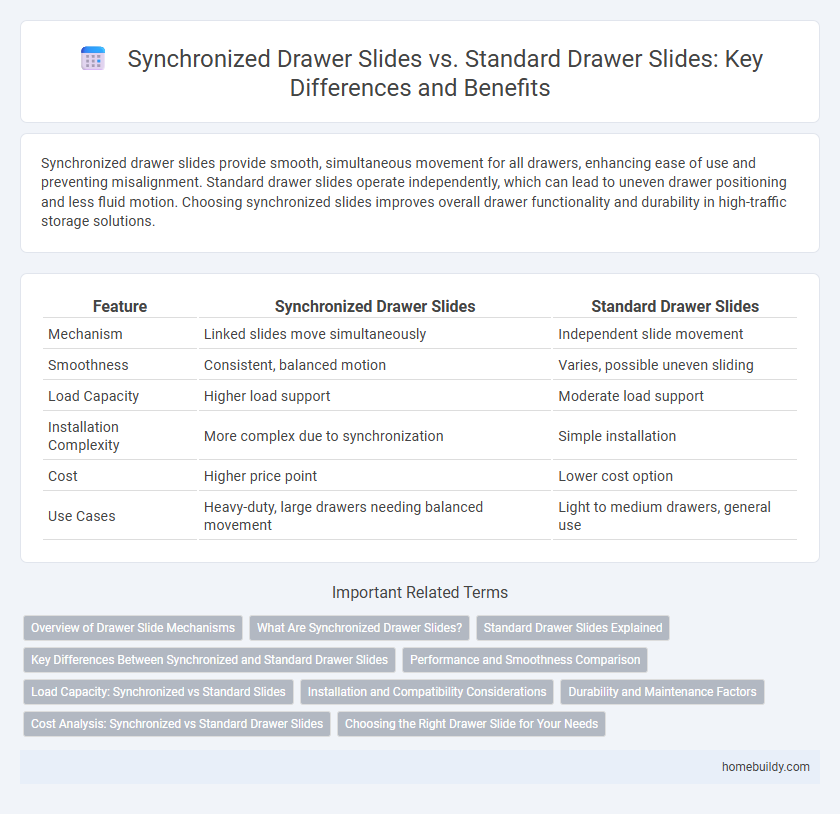Synchronized drawer slides provide smooth, simultaneous movement for all drawers, enhancing ease of use and preventing misalignment. Standard drawer slides operate independently, which can lead to uneven drawer positioning and less fluid motion. Choosing synchronized slides improves overall drawer functionality and durability in high-traffic storage solutions.
Table of Comparison
| Feature | Synchronized Drawer Slides | Standard Drawer Slides |
|---|---|---|
| Mechanism | Linked slides move simultaneously | Independent slide movement |
| Smoothness | Consistent, balanced motion | Varies, possible uneven sliding |
| Load Capacity | Higher load support | Moderate load support |
| Installation Complexity | More complex due to synchronization | Simple installation |
| Cost | Higher price point | Lower cost option |
| Use Cases | Heavy-duty, large drawers needing balanced movement | Light to medium drawers, general use |
Overview of Drawer Slide Mechanisms
Synchronized drawer slides feature linked mechanisms that ensure both sides of the drawer move simultaneously and smoothly, providing enhanced stability and preventing misalignment. Standard drawer slides operate independently on each side, which can lead to uneven movement and increased wear over time. The synchronized design improves load distribution and user experience by maintaining consistent drawer motion and alignment.
What Are Synchronized Drawer Slides?
Synchronized drawer slides feature a mechanism that ensures both sides of the drawer extend and retract simultaneously, providing smooth and balanced movement. This design minimizes drawer misalignment and reduces wear on the slides by distributing forces evenly across both sides. Compared to standard drawer slides, synchronized slides enhance user experience through improved stability and durability, making them ideal for heavy or wide drawers.
Standard Drawer Slides Explained
Standard drawer slides consist of two metal rails allowing drawers to open and close smoothly but operate independently without synchronization. These slides are commonly used in residential furniture due to their affordability and ease of installation. Compared to synchronized drawer slides, standard slides lack coordinated movement, resulting in less stability when multiple drawers are opened simultaneously.
Key Differences Between Synchronized and Standard Drawer Slides
Synchronized drawer slides feature a specialized mechanism that enables both sides of the drawer to extend simultaneously, ensuring smooth and balanced operation, unlike standard drawer slides which operate independently on each side. This synchronization improves stability and reduces wear, making synchronized slides ideal for heavy or wide drawers requiring consistent alignment. Standard drawer slides are more common and cost-effective but can result in uneven movement, causing potential misalignment or jamming over time.
Performance and Smoothness Comparison
Synchronized drawer slides offer enhanced performance by allowing multiple drawers to open and close simultaneously with balanced movement, reducing wear and extending lifespan. Standard drawer slides typically operate independently, which can result in uneven motion and increased friction during use. The synchronized mechanism ensures smoother, quieter operation ideal for high-use environments where consistent, reliable drawer function is critical.
Load Capacity: Synchronized vs Standard Slides
Synchronized drawer slides distribute weight evenly across dual mechanisms, significantly increasing load capacity compared to standard drawer slides, which rely on individual sliding elements. This balanced load distribution reduces wear and enhances durability, making synchronized slides ideal for heavier drawers in industrial or high-use applications. Standard slides, while suitable for lighter loads, may experience quicker degradation under weight stress, limiting their effectiveness in demanding environments.
Installation and Compatibility Considerations
Synchronized drawer slides require precise alignment during installation to ensure smooth, simultaneous movement of multiple drawers, often necessitating specialized tools or templates, while standard drawer slides offer more straightforward installation with greater tolerance for minor misalignments. Compatibility considerations for synchronized slides include matching drawer sizes and weights to maintain balanced operation, contrasting with standard slides that accommodate a broader range of drawer dimensions and hardware configurations. Selecting the appropriate slide type depends on the specific cabinetry design and desired performance, with synchronized slides favored in high-end or custom applications where synchronized motion enhances functionality.
Durability and Maintenance Factors
Synchronized drawer slides feature a robust design with dual rails that ensure even weight distribution, significantly enhancing durability compared to standard single-rail drawer slides prone to faster wear and tear. Maintenance of synchronized slides is typically lower due to precision engineering that reduces friction and prevents misalignment, while standard slides often require more frequent lubrication and adjustment to maintain smooth operation. The higher build quality and material resilience in synchronized drawer slides contribute to longer lifespan and reduced maintenance costs in high-usage environments.
Cost Analysis: Synchronized vs Standard Drawer Slides
Synchronized drawer slides typically cost 20-40% more than standard drawer slides due to their complex mechanism that ensures even, smooth operation on both sides of the drawer. Standard drawer slides offer basic functionality at a lower price but may lack the durability and alignment accuracy of synchronized models. Investing in synchronized drawer slides can reduce long-term maintenance costs and improve user experience, justifying the higher initial expense for quality applications.
Choosing the Right Drawer Slide for Your Needs
Synchronized drawer slides provide smooth, simultaneous movement of multiple drawer sections, enhancing stability and ease of access, making them ideal for complex, multi-tiered drawers. Standard drawer slides offer reliable, straightforward functionality suitable for single-drawer setups with less frequent use or lower weight capacity. Selecting the right drawer slide depends on drawer size, load requirements, and desired glide quality to ensure optimal performance and longevity.
Synchronized drawer slides vs Standard drawer slides Infographic

 homebuildy.com
homebuildy.com